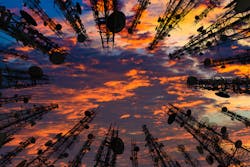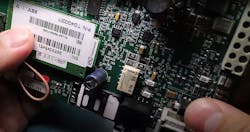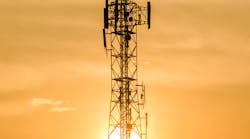Yet another technology shift is coming to the cellular industry that will significantly affects the security industry; however, with effective planning, integrators can help customers navigate this change – and even add value to current contracts to increase monthly recurring revenue.
An efficient 2G, 3G and CDMA sunset strategy today means fewer problems for tomorrow. Whether it is takeovers, upgrades or new installs, LTE is the way to go.
Just like the 2G in 2016, 3G is on its way out. So, too is CDMA technology. A common misconception is that the sunset will happen on the announced date, like a metaphorical “off switch.” The reality is that those dates are when the sunset will be completed, so signal quality and allocated bandwidth will likely be affected in the months leading up to those dates.
Other factors, such as Hurricane Laura, can influence the sunset date beyond what cellular companies have agreed to with vendors. In late August, Hurricane Laura knocked down many of the signal towers in Louisiana and Texas, and carriers are likely to take advantage of this opportunity and upgrade those towers to LTE, as they are unlikely to replace damaged towers with 3G technology.
The FCC reports that more than 350 cell towers across Louisiana were out of service due to transport issues, damage to the tower, or power outages; in fact, Telguard pulled a report of all of its cellular communication devices in southwest Louisiana (Cameron, Calcasieu, Jefferson Davis, Acadia and Vermilion parishes), which showed only 37% of CDMA units in the area reported back on August 27th or after. On the other hand, for the same carrier, 75% of LTE units reported back on the same day.
5 Steps to a Successful Sunset Strategy
Early planning is vitally important, and starting now allows plenty of time to contact reluctant clients multiple times. This also ensures the extra labor can be spread out over months to avoid exceeding capabilities. Early adopters can take advantage of sales and discounts offered by vendors as some have implemented an aggressive sunset strategy including hardware discounts.
While the sunsets are a big change that will touch many of your customers, starting a detailed implementation strategy today now will ensure that you and your customers are not caught off-guard. Here are five steps to planning and implementing a successful 3G sunset strategy that will prepare for a successful transition.
1. Understand the event and options: The first step to creating a strategy is to gather information about the cellular carrier technology your customers use – 3G, CDMA, LTE – as well as the activation dates and services rendered. Having this information will allow you to prioritize which customers to reach out to first. Replacing a communications device might be less daunting if available options are known. An integrator could offer replacement hardware or software upgrades that specifically target the sunset event as part of an ongoing sales process and that could make the transition easier. Get acquainted with these options early.
2. Take inventory: The next step is to take an inventory of existing 3G and CDMA stock. It is important to understand if there is value in products that will become obsolete due to the sunset. While CDMA units can no longer be activated, 3G units that were previously activated might be able to be reused for new installations, so their value is not necessarily lost yet.
3. Understand labor capacity and 3G/CDMA population: Now that you have taken stock of your customers and inventory, it is time to take stock of your internal capabilities, as each customer is going to need to replace a physical device, which means an expense on hardware and labor. Ask a few questions:
- What is the cellular carrier technology in use by customers?
- What are the activation dates and current services being rendered?
- What is the most efficient way to handle same-brand replacements from both physical installation and programming perspectives?
Integrators want to continue to grow their subscriber base and thus, overall sales. A self-assessment of how much effort can be devoted to the sunset without interfering with “usual business” is critical. This will serve as a guideline for setting expectations of the strategy.
4. Create a strategy: Now it is time to prioritize. A good place to start is to sort customers by activation date andFollowing a prioritization strategy ensures that you maximize the perceived value of the old unit in your customers’ minds. For example, if you have 1,000 subscribers with 3G devices – 500 of which have an activation date in 2016 and 500 in 2015 – you would want to start with the 2015 activations.
A key point of the strategy is understanding how many units need to be converted and time left – to set a pace of conversion that the integrator is trying to achieve. For example, replacing 20 units in 10 months means that at least two units a month need to be converted. Dealing with numbers as opposed to abstract concepts makes the strategy easy to track.
When a technician is going to be on-site to swap out the old technology, this appointment also presents an opportunity to add value by offering the customer new services and options. Something as simple as providing a full system check or anything that does not add much time to the replacement can add value for a customer.
Additionally, think of ways to increase RMR while reducing the initial cost for the customer. An easy way to do this in the residential space would be to offer a reduced installation fee for an interactive feature.
5. Act on the plan: It is human nature to put off decisions that seem far away, but it is important to develop a communications strategy. At this point, it is also helpful to think about how you generally communicate with customers – direct phone calls, email, invoice stuffers, physical mailers, newsletters, blogs, texts, social media, website updates, etc. – so you can plan for communication about the sunset as well as your services. It is important to develop a unified message, so the customer is hearing the same information from your organization – from customer service representatives to installers. Several attempts across the different methods ensure the customer gets the message.
Prepare to Adapt
As the strategy is put into action, things may not go according to plan – customer response may vary over time or network changes may force an integrator to focus on different units than planned. When it comes to technology sunsets, one thing is certain: Integrators must be ready to frequently analyze the results and measure against the expected pace of conversion and adjust to get back on track.
In the internet era, it is easy to search and find contradicting information. That is why it is important to provide your customers with detailed, but easy-to-digest information from a reliable source. Here are some talking points to help streamline the message:
- The sunset is an inevitable carrier event that is part of the natural evolution of technology.
- Equipment manufacturers and integrators are affected as well.
- Current devices will stop working by a specific date at the latest, and we want to address it before any issues appear.
- By installing an LTE radio, we are providing the most up-to-date technology available that will serve you for a long time.
Daniel Rosales is Senior Director of Technical Service and Support for Telguard, a business unit of Ametek Inc. Request more info about the company at www.securityinfowatch.com/10215328.






